Click on images to enlarge
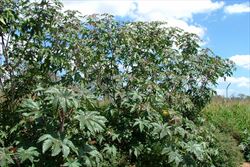
infestation (Photo: Sheldon Navie)
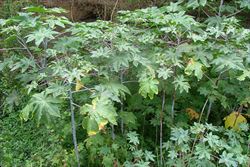
habit (Photo: Sheldon Navie)
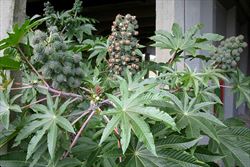
habit (Photo: Sheldon Navie)
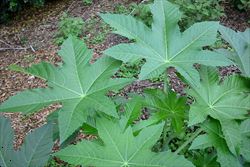
the large palmately lobed leaves (Photo: Sheldon Navie)
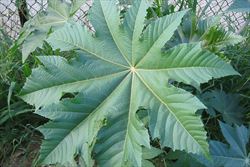
leaf with nime lobes (Photo: Sheldon Navie)
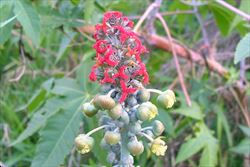
flower cluster with separate red female flowers and yellow male flowers (Photo: Sheldon Navie)
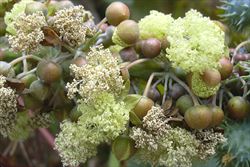
close-up of male flowers (Photo: Forest and Kim Starr, USGS)
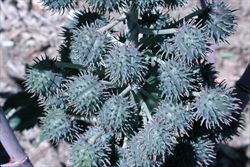
immature fruit (Photo: Sheldon Navie)
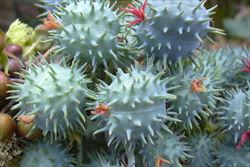
close-up of immature fruit (Photo: Forest and Kim Starr, USGS)
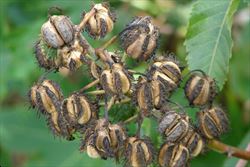
mature fruit (Photo: Forest and Kim Starr, USGS)
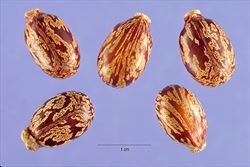
close-up of seeds (Photo: Steve Hurst at USDA PLANTS Database)
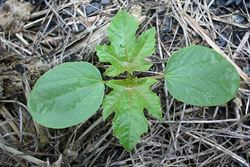
young seedling with large cotyledons (Photo: Sheldon Navie)
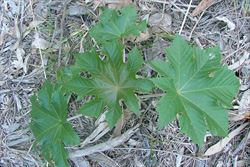
young plant (Photo: Sheldon Navie)

leaves of Ricinus communis 'Carmencita' (Photo: Sheldon Navie)
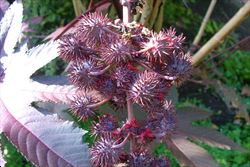
immature fruit of Ricinus communis 'Carmencita' (Photo: Sheldon Navie)
Scientific Name
Ricinus communis L.
Family
Euphorbiaceae
Common Names
African coffee tree, castor, castor bean, castor bean plant, castor oil bush, castor oil plant, castor oil tree, castorbean tree, castor-oil plant, maple weed, Palma Christi, Palma-christi, wonder tree
Origin
This species probably originated in Africa, but is now widespread throughout the tropical and sub-tropical regions of the world.
Cultivation
This species is still occasionally seen growing in gardens, particularly cultivars with reddish-coloured leaves and fruit (e.g. Ricinus communis 'Carmencita Red').
Naturalised Distribution
A very widespread species that is most commonly naturalised in the coastal and sub-coastal districts of Queensland, New South Wales and south-western Western Australia. Scattered populations also occur throughout other parts of these states. It has also been recorded from the Northern Territory, South Australia, Victoria, and several offshore island territories (i.e. Norfolk Island, Christmas Island, Lord Howe Island and the Cocos Islands).
Widely naturalised overseas, including in the USA, Mexico, South America, New Zealand and on numerous Pacific islands (e.g. American Samoa, Western Samoa, Fiji, Guam, Hawaii, French Polynesia, the Cook Islands, the Galápagos Islands, Kiribati, Nauru, New Caledonia, Niue, Palau, the Solomon Islands and Tonga).
Habitat
A weed of creek banks (i.e. riparian areas), dry riverbeds, waterways, roadsides, railways, disturbed sites, pastures, gardens, neglected suburban areas and other waste areas in tropical, sub-tropical, temperate and sometimes also semi-arid environments.
Habit
A long-lived (i.e. usually perennial) shrub often growing up to 3 m tall, but occasionally reaching up to 10 m in height.
Distinguishing Features
- a large robust shrub often growing 3 m or more in height.
- its thick, hollow, hairless stems bear large leaves up to 70 cm across.
- these leaves usually have 7-9 finger-like lobes and the leaf stalk is attached to their undersides.
- separate male and female flowers are borne in elongated clusters (8-15 cm long), with the reddish female flowers on top and the yellowish male flowers below.
- its capsules (10-30 mm across) are greenish to bright red when young and covered in soft, blunt spines.
Stems and Leaves
The thick stems are generally greyish-green in colour (i.e. glaucous), but sometimes they have a reddish tinge. They are moderately branched, hollow, and hairless (i.e. glabrous). Older stems turn greyish in colour and may become somewhat woody.
The alternately arranged hairless (i.e. glabrous) leaves are borne on stalks (i.e. petioles) 10-30 cm long and have very large leaf blades (10-70 cm long and 15-60 cm wide). The leaf stalks (i.e. petioles) are usually attached directly to the undersides of the leaves (i.e. the leaves are peltate). The leaf blades have 5-10 (usually 7-9) spreading finger-like lobes (i.e. the leaves are palmately-lobed) with pointed tips (i.e. acute apices). Each of the lobes has a prominent vein running down its centre and its margins are finely toothed (i.e. serrate). Young leaves are often dark red or purplish in colour and usually somewhat glossy in appearance, while older leaves are green or bluish-green in colour.
Flowers and Fruit
The large elongated flower clusters (8-15 cm long) are usually produced near the tips of the branches (i.e. in terminal, or sometimes axillary, racemes). Separate male and female (i.e. unisexual) flowers are present in these clusters (i.e. the plants are monoecious). Both flower types are borne on stalks (i.e. pedicels) up to 10 mm long and do not have any petals, but they do have three to five small sepals (5-8 mm long). The cream or yellow male (i.e. staminate) flowers are produced at the base of the flower clusters and have about 100 stamens. The female (i.e. pistillate) flowers have large three-segmented ovaries with three feathery bright red styles and are produced at the top of the flower clusters. Flowering occurs all year round but is most abundant during late spring, summer and early autumn (i.e. from November to March).
The egg-shaped (i.e. ovoid), rounded (i.e. globular), or slightly three-lobed fruit are greenish, greenish-red or bright red in colour when young and covered in soft blunt spines. These capsules (10-30 mm across) turn brown as they mature and divide into three segments, each containing a single seed. The seeds are mottled grey and brown (10-17 mm long and 6-10 mm wide), smooth in texture, somewhat oval in shape (i.e. oblong-ellipsoid), and have a small fleshy projection (i.e. aril) at one end.
Reproduction and Dispersal
This plant reproduces entirely by seed.
The seeds are explosively released when the fruit are mature, thereby aiding their spread. They are also often dispersed by floodwaters and animals (e.g. rodents and birds). Humans also spread the seeds in dumped garden waste, mud, soil and on vehicles and machinery.
Environmental Impact
Castor oil plant (Ricinus communis) is regarded as an environmental weed in Queensland, New South Wales, the Northern Territory, Western Australia, Victoria, South Australia and on Christmas Island. It was also recently listed as a priority environmental weed in at least one Natural Resource Management region.
Other Impacts
The seeds of this species are extremely toxic to humans and livestock.
Legislation
This species is declared under legislation in the following states and territories:
- New South Wales: Class 3 - a regionally controlled weed. The relevant local control authority must be promptly notified of the presence of this weed and it must be fully and continuously suppressed and destroyed (on Lord Howe Island only), and Class 4 - a locally controlled weed. The growth and spread of this species must be controlled according to the measures specified in a management plan published by the local control authority and the plant may not be sold, propagated or knowingly distributed (in numerous local authority areas). See the New South Wales Department of Primary Industries Noxious Weeds List at http://www.dpi.nsw.gov.au for more detailed information on which local areas are covered in these declarations.
- Northern Territory: B - spread to be controlled (throughout all of the Territory), and C - not to be introduced into the Territory.
- Western Australia: Unassessed - this species is declared in other states or territories and is prohibited until assessed via a weed risk assessment (throughout the entire state).
Management
For information on the management of this species see the following resources:
- the Biosecurity Queensland Fact Sheet on this species, which is available online at http://www.dpi.qld.gov.au.
- the Northern Territory Department of Natural Resources, Environment and The Arts Agnote on this species, which is available online at http://www.nt.gov.au/weeds.
Similar Species
Castor oil plant (Ricinus communis) can be confused with bellyache bush (Jatropha gossypiifolia) and physic nut (Jatropha curcas). These species can be distinguished by the following differences:
- castor oil plant (Ricinus communis) has hairless (i.e. glabrous) leaves that are usually divided into 7-9 pointed finger-like lobes (i.e. they are palmately lobed). Separate male and female flowers (both lacking petals) are borne together in large elongated clusters (8-15 cm long), with the male flowers below the female flowers. Its immature fruiting capsules are densely covered in soft blunt spines, but are hairless (i.e. glabrous).
- bellyache bush (Jatropha gossypiifolia) has leaves covered in sticky (i.e. glandular) hairs that are deeply divided into 3-5 pointed lobes (i.e. they are palmately-lobed). The small flowers have five red 'petals' and are borne in small branched clusters. Its fruiting capsules are bright glossy green and sometimes sparsely hairy (i.e. sparsely pubescent).
- physic nut (Jatropha curcas) has hairless (i.e. glabrous) leaves that are shallowly divided into 3-5 rounded lobes (i.e. they are palmately-lobed). The small flowers have five greenish-yellow 'petals' and are borne in small branched clusters. Its fruiting capsules are dull yellow and hairless (i.e. glabrous).

